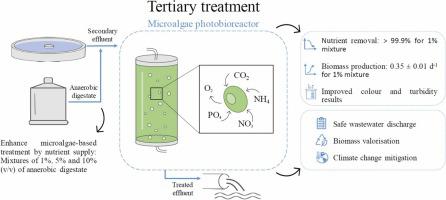当前位置:
X-MOL 学术
›
Environ. Technol. Innov.
›
论文详情
Our official English website, www.x-mol.net, welcomes your feedback! (Note: you will need to create a separate account there.)
Enhancing urban wastewater treatment: Chlorella vulgaris performance in tertiary treatment and the impact of anaerobic digestate addition
Environmental Technology & Innovation ( IF 7.1 ) Pub Date : 2024-03-19 , DOI: 10.1016/j.eti.2024.103601 S.A. Sousa , A.F. Esteves , E.M. Salgado , J.C.M. Pires
Environmental Technology & Innovation ( IF 7.1 ) Pub Date : 2024-03-19 , DOI: 10.1016/j.eti.2024.103601 S.A. Sousa , A.F. Esteves , E.M. Salgado , J.C.M. Pires

|
The rising urban wastewater discharge into waterways resulted in harmful environmental effects. Microalgae can bioremediate wastewaters by removing contaminants such as nitrogen and phosphorus and can be rather tolerant to toxic compounds. Managing the anaerobic digestate resulting from sludge treatment in wastewater treatment plants faces some obstacles related to its high contaminant content. This work aims to study the ability of the microalga to perform the tertiary treatment of urban wastewater, assessing its growth, nutrient removal and the effect of the addition of digestate at different concentrations in this treatment phase. A secondary effluent was supplied with 1% (M1), 5% (M5) and 10% (M10) (v/v) of anaerobic digestate and used to culture microalgae. An assay using only secondary effluent was also performed (S). grew successfully in all effluents except for the M10, and the highest specific growth rate was obtained in the M1 assay, 0.35 ± 0.01 d. Ammonium-nitrogen was completely removed in the S, M1 and M5 assays (>99.9%). Microalgae successfully removed phosphate-phosphorus from the tested effluents, achieving a negligible concentration in the M1 assay and a removal efficiency of 96.2 ± 0.2%, 51 ± 2%, and 43 ± 3% in S, M5 and M10, respectively. These results showed that microalgal cultures could efficiently remediate the secondary effluent and its mixture with 1% (v/v) of anaerobic digestate, achieving nutrient concentrations below the current legislation limits and the more restrictive limits predicted for future legislation.
中文翻译:

加强城市废水处理:普通小球藻在三级处理中的性能以及厌氧消化物添加的影响
流入水道的城市废水排放量不断增加,对环境造成了有害影响。微藻可以通过去除氮和磷等污染物来生物修复废水,并且对有毒化合物具有相当的耐受性。管理废水处理厂污泥处理产生的厌氧消化物面临着一些与其高污染物含量相关的障碍。本工作旨在研究微藻对城市废水进行三级处理的能力,评估其生长、营养物去除以及在此处理阶段添加不同浓度消化物的效果。二级流出物中含有 1% (M1)、5% (M5) 和 10% (M10) (v/v) 的厌氧消化物,用于培养微藻。还进行了仅使用二级流出物的测定(S)。除 M10 外,所有废水中均能成功生长,并且在 M1 测定中获得了最高的比生长速率,为 0.35 ± 0.01 d。在 S、M1 和 M5 测定中,铵态氮被完全去除 (>99.9%)。微藻成功地从测试的废水中去除了磷酸盐,在 M1 测定中达到了可忽略不计的浓度,并且在 S、M5 和 M10 中的去除效率分别为 96.2 ± 0.2%、51 ± 2% 和 43 ± 3%。这些结果表明,微藻培养物可以有效地修复二级污水及其与 1% (v/v) 厌氧消化物的混合物,使营养物浓度低于当前立法限制和未来立法预测的更严格的限制。
更新日期:2024-03-19
中文翻译:

加强城市废水处理:普通小球藻在三级处理中的性能以及厌氧消化物添加的影响
流入水道的城市废水排放量不断增加,对环境造成了有害影响。微藻可以通过去除氮和磷等污染物来生物修复废水,并且对有毒化合物具有相当的耐受性。管理废水处理厂污泥处理产生的厌氧消化物面临着一些与其高污染物含量相关的障碍。本工作旨在研究微藻对城市废水进行三级处理的能力,评估其生长、营养物去除以及在此处理阶段添加不同浓度消化物的效果。二级流出物中含有 1% (M1)、5% (M5) 和 10% (M10) (v/v) 的厌氧消化物,用于培养微藻。还进行了仅使用二级流出物的测定(S)。除 M10 外,所有废水中均能成功生长,并且在 M1 测定中获得了最高的比生长速率,为 0.35 ± 0.01 d。在 S、M1 和 M5 测定中,铵态氮被完全去除 (>99.9%)。微藻成功地从测试的废水中去除了磷酸盐,在 M1 测定中达到了可忽略不计的浓度,并且在 S、M5 和 M10 中的去除效率分别为 96.2 ± 0.2%、51 ± 2% 和 43 ± 3%。这些结果表明,微藻培养物可以有效地修复二级污水及其与 1% (v/v) 厌氧消化物的混合物,使营养物浓度低于当前立法限制和未来立法预测的更严格的限制。



























 京公网安备 11010802027423号
京公网安备 11010802027423号